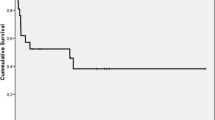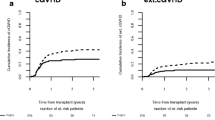Abstract
With the success of post-transplant cyclophosphamide based platform and improved clinical care, the number of haploidentical stem cell transplants (HaploSCT) have surged over the last decade. However, data from India is scarce. We aimed to evaluate the outcome of haploSCT at our centre. Since the inception of government schemes, many patients at our centre are able to undergo transplantation at subsidized cost. We conducted a retrospective analysis of the haploidentical transplants performed between January 2015 and November 2022. Fifty patients were eligible for this study. Patient details were obtained from case files. The graft versus host disease (GVHD) prophylaxis was post-transplant Cyclophosphamide (PTCy) with Mycophenolate-mofetil and Cyclosporine/tacrolimus/sirolimus. All patients were transfused peripheral blood stem cells from donors. Post-transplant, patients continued regular follow up as per schedule. Supportive care was given as per unit protocol. Overall survival (OS) was calculated using the Kaplan–Meier method. Fifty patients underwent haploSCT. A total of fifty patients with a median age of 20 years (range 3–53 years) underwent haploidentical HSCT from a family donor. Twenty three (46%) patients were > 18 years age and 82% were males. Indications for transplant included both benign and malignant hematological diseases. Most common conditioning regimen used was Fludarabine + Busulphan + Cyclophosphamide (n = 38, 76%). Thirty five patients (70%) engrafted successfully. In the patients who had successful engraftment, the median time to neutrophil engraftment was 16 days (range 10–20 days) and platelet engraftment was 18 days (range 10–32). Fourteen patients developed acute GVHD (28%), and three patients developed chronic GVHD (6%). The median follow-up was 30 months and the two-year OS was 43% with a median OS of 17 months. Twenty-one (adult = 9, pediatric = 12) out of 50 patients (42%) are alive and on regular follow-up. HaploSCT with a PTCy platform is a cost-effective, promising modality of treatment in patients who have no suitable matched donors and are not affording matched unrelated transplants. At our centre, we were able to achieve acceptable results with use of generic medications at affordable cost. Transplant Related Mortality (TRM) rates were comparable to other centres, however, multi-drug resistant bacterial infection remains a challenge in performing haploidentical HSCT in develo** countries.

Similar content being viewed by others
References
Dedhia L, Gadekar S, Mehta P et al (2015) HLA haplotype diversity in the South Indian population and its relevance. Indian J Transplant 9:138–143
ISBMT Activity report (2021)
McCurdy SR, Kanakry JA, Showel MM et al (2015) Risk-stratified outcomes of nonmyeloablative HLA-haploidentical BMT with high-dose posttransplantation cyclophosphamide. Blood 125(19):3024–3031
Batra A, Perumal Kalaiyarasi J, Kannan K et al (2021) Haploidentical hematopoietic stem cell transplantation in leukemia’s: experience from a cancer center in India. Indian J Hematol Blood Transfus 37(3):463–471. https://doi.org/10.1007/s12288-020-01374-w
Jaiswal SR, Chakrabarti A, Chatterjee S et al (2016) Haploidentical transplantation in children with unmanipulated peripheral blood stem cell graft: the need to look beyond post-transplantation cyclophosphamide in younger children. Pediatr Transpl 20(5):675–682
George B, Kulkarni U, Lionel S et al (2022) Haploidentical transplantation is feasible and associated with reasonable outcomes despite major infective complications-A single center experience from India. Transplant Cell Ther 28(1):45.e1-45.e8
Nataraj KS, Prabhu S, Bhat S et al (2020) Hematopoietic stem cell transplant outcomes in patients with acute myeloid leukemia from a tertiary care center in South India. Biol Blood Marrow Transplant 26:123–124
Kharya G, Jaiswal SR, Bhat S et al (2023) Impact of conditioning regimen and graft-versus-host disease prophylaxis on the outcome of haploidentical peripheral blood stem cell transplantation for high-risk severe aplastic anemia in children and young adults: a report from the pediatric severe aplastic anemia consortium of India. Transplant Cell Ther 29(3):199.e1-199.e10
Bhat S, Ngangbam S, Iqbal W et al (2017) Outcomes of myeloablative haploidentical hematopoietic stem cell transplant in pediatric patients with TCR a/b; and CD 19 depletion. Biol Blood Marrow Transplant 23:S191–S192
Hutt D (2018) Engraftment, graft failure, and rejection. In: Kenyon M, Babic A (eds) The European blood and marrow transplantation textbook for nurses: under the auspices of EBMT. Springer, Cham, p 13
Aggarwal M, Agrawal N, Ahmad R et al (2016) Haploidentical stem cell transplant: established treatment, expanding horizons. Asian J Oncol 2:8–13
Funding
Nil.
Author information
Authors and Affiliations
Corresponding author
Ethics declarations
Conflict of interest
The authors have no conflicts of interest.
Ethical approval
Approved by the Institutional Review Board of the GCRI.
Additional information
Publisher's Note
Springer Nature remains neutral with regard to jurisdictional claims in published maps and institutional affiliations.
Rights and permissions
Springer Nature or its licensor (e.g. a society or other partner) holds exclusive rights to this article under a publishing agreement with the author(s) or other rightsholder(s); author self-archiving of the accepted manuscript version of this article is solely governed by the terms of such publishing agreement and applicable law.
About this article
Cite this article
Garg, A., Trivedi, M., Raj, A. et al. Haploidentical Stem Cell Transplantation: Half Match but More Hope!—Single Centre Experience from Western India. Indian J Hematol Blood Transfus 40, 385–391 (2024). https://doi.org/10.1007/s12288-023-01722-6
Received:
Accepted:
Published:
Issue Date:
DOI: https://doi.org/10.1007/s12288-023-01722-6




